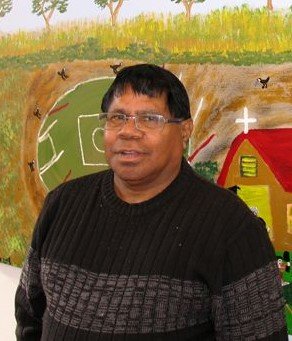IAN W. ABDULLA
BIOGRAPHY

Photo: Anthony Bond art dealer
Ngarrindjeri artist Ian Abdulla has lived at Cobdolga, an early irrigation settlement in the Riverland region of South Australia all his life. The township is located beside the Murray River; it’s name a corruption of Cobdogle, the ‘king’ of the local Aboriginal tribe. Abdulla grew up by the swamp, formed when the system of locks changed the river level, a haven for water birds, especially pelicans.
He began painting in the late eighties, a period of cultural renaissance in Cobdolga, due in large measure to mentorship from art activist and teacher Steve Fox, who had taken an extended break from his role as art adviser at Yirrkala in North East Arnhem Land. Abdulla captured the prevailing mood of his community when he told Steve Fox that he couldn’t draw and that his mob had no culture left. ‘That was just on the surface though’, Fox later recalled, ‘ it all changed the more we talked ’. (Fox, Artlink) and despite Abdulla’s early misgivings about his creative potential, his work evolved and found an appreciative audience.
Through his painting Abdulla came to relate the simple narrative stories that recorded his recollections of times and deeds that illuminated the life of the local Aboriginal people living in rural poverty. Growing up in the 50’s and 60’s, his personal childhood memories, though simply told, are far from simple and importantly, are deeply grounded in historical context, a perspective that is at once personal and political, though gently so. In time Abdulla became the most successful of the Cobdolga artists. While much of their art was narrative, contemporary and political, Abdulla himself tended away from the overtly political and developed a quieter, more reflective style, which garnered considerable popular attention, and even affection, from the mainstream public.
“I can only paint what I know to be true,” Abdullah says, revealing the sense of authenticity that lends gravitas to his naïve painting style. Human figures, tenuous within the painted landscape of mountains, trees, birds and animals, go about their activities integrated within, rather than imposed upon the background. The overall effect is one of continuity between a unique environment and its human inhabitants. Most of his paintings are annotated, and it is the text, centred in the visual forefront of the image, that provides the link between these naive images and the broader historical framework of Aboriginal dispossession and inequity.
Although his work has remained stylistically consistent throughout his career, more recent paintings have departed somewhat from stories of his childhood to address contemporary issues. The vanished river life is replaced by the modern day hardships of life in Cobdolga; alcoholism, unemployment, violence and prison life. The childlike, figurative narrative delivers these stories simply as ‘truth’, recording events with a certain sense of objectivity and largely without judgement. Prominent attention to background surroundings still conveys the sense that human intention is subject to greater forces. In his painting Here is Where the Angels Carried Me to The Front Step When I Was Walking Around the Mission Looking For a Head Strainer, 1999, Abdulla leaves behind the innocence of childhood and tells an adult story of hope and redemption. For an artist who initially maintained that, ‘ In the future my paintings wont change much from what they are today ‘(Murphy (ed) 1992, 14), this direction is compelling. The lack of artifice always evident in Abdulla’s work reflects his opinion that what ultimately matters more than anything, is that these stories are told.
The sense that Abdulla is a ‘people’s artist’, and a storyteller creating works for his own community as much as for a wider audience has sat relatively comfortably alongside his commercial success and artistic recognition. His representation through Paul Greenaway in Adelaide and the Hogath Gallery in Sydney has been stable and enduring built, as it is, upon the same deep personal feelings that he imparts so successfully in his art. Over time he has come to occupy a unique position within the broader canon of Aboriginal Art as a contemporary voice outside of the ‘urban contemporary’ framework.
Ian Abdulla’s work has been recognised in many ways since it gained recognition in the early 1990’s. He was awarded South Australian Aboriginal Artist of the Year in 1991 and an Australia Council Fellowship in the following year. On two occasions he was runner up in the National Indigenous Heritage Art Award and in 1996 he won the General Painting section of the Testra National Aboriginal and Torres Strait Islander Art Award. His work has been developed into two popular children’s books that deal with social and environmental issues, As I Grew Older (1993) and Tucker (1994); and attesting to his enduring popularity his life and art were the subject of the play Riverland directed by Wesley Enoch for the Adelaide Festival in 2007.
© Adrian Newstead
References:
Fox, Steve, “Letter from Arnhem Land where all the Real Art is supposed to be”, Artlink, Vol 10, # 1,2, p 68-69, (year?)
Murphy, Bernice, (ed), “Tyerabarrowaryaou: I shall never become a white man”, Museum of Contemporary Art, Sydney Australia, 1992
Crasswell, Penny, “Ian W Abdulla: Elvis has entered the building”, Sydney Morning Herald, September 20, 2003.

